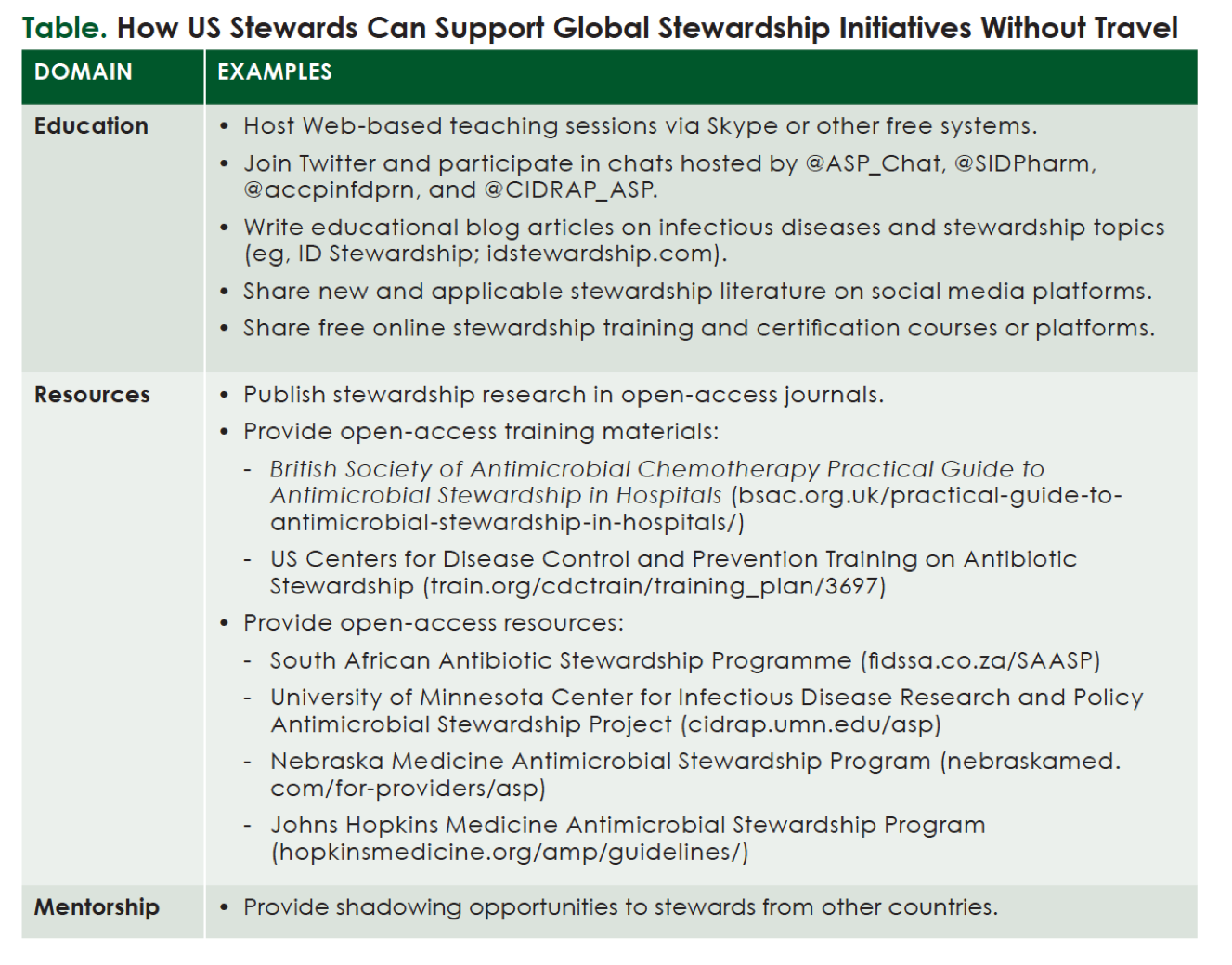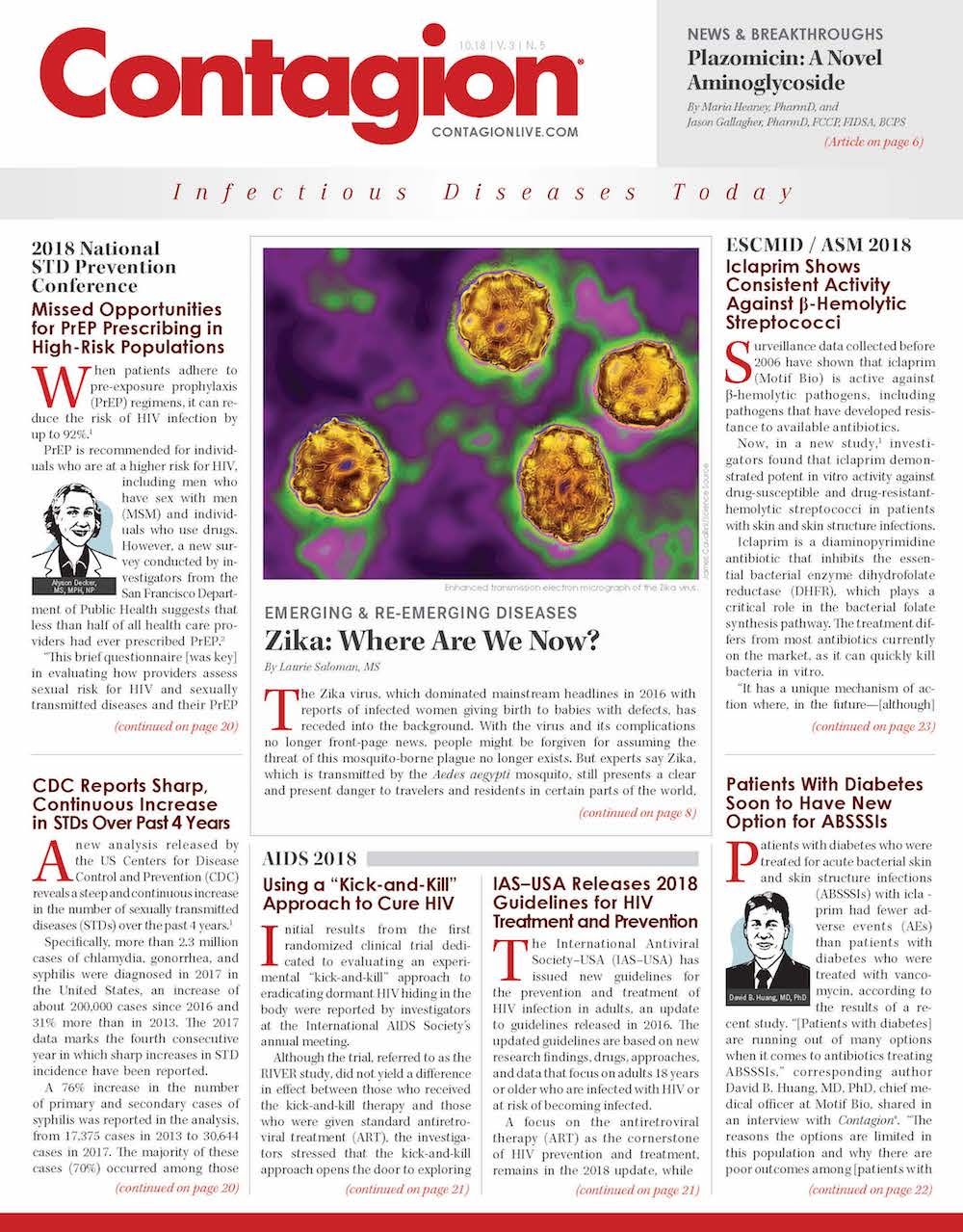Globalization of Antibiotic Stewardship Programs: The World Is Waiting
The globalization of antibiotic stewardship programs is necessary in the fight against antibiotic resis­tance.
The globalization of antibiotic stewardship programs is necessary in the fight against antibiotic resis­tance.1 Individual countries must take meaningful actions to counter antimicrobial resistance, tailoring implemen­tation according to their national circumstances. One of the key challenges is preventing the overprescription of antibiotics in hospitals. Every unnecessary dose of antibiotics contributes to the escalating rate of antimicrobial resistance. The unrestrained use of anti­biotics is the main driver for the rise in drug-resistant infec­tions, which now kill more than half a million people every year worldwide, including 50,000 in Europe and the United States combined. Despite efforts by the US Centers for Disease Control and Prevention, the World Health Organization, the United Nations (UN), and others to encourage more prudent use of antibiotics, an international team of investigators found a 65% rise in worldwide consumption of antibiotics from 2000 to 2015.2 The increase in 76 countries was driven almost entirely by rising use in low- to middle-income countries (LMICs). Of particular concern is the escalating global use of antibiotics of last resort, such as colistin. To address the overprescription of antibiotics in hospitals, we need a scalable and proven solution that can be implemented on a global basis.
GLOBAL CALL TO ACTION FOR ASP
The UN issued a call to action for countries to implement antibiotic stewardship to address antimicrobial resistance and overuse of antibi­otics, although action to tackle antimicrobial resistance has not yet matched the scale of the threat. The problem is worse in LMICs. Building on current work supported by multiple organizations in the areas of surveillance and antibiotic resistance, implementation of antibiotic stewardship programs to assure optimal use of antibiotics is equally important. Documenting antibiotic resistance rates from surveillance programs will not result in any meaningful change in antibi­otic use if hospitals do not have trained health care providers who know how to apply surveillance data to make an antibiotic stewardship intervention at the point of care.
ASP IN LMICS
ASPs are desperately needed in hospitals; however, a shortage of adequately trained pharmacists and physicians in infectious diseases creates a challenge. Pharmacy practice models vary significantly in developing countries, with barriers to effective practice models including acute shortages of qualified pharma­cists, no implementation of dispensing separation practices, and weak regulatory enforcement of drug sales. Pharmacists, while not always clinically empowered, are present in point-of-care moments and can help change physician behavior. Antibiotic stewards from resource-rich countries such as the United States must help LMICs implement ASPs. Elements of successful anti­biotic stewardship in hospitals in LMICs have been developed by investigators working with 15 experts (including Dr. Goff) from 13 countries on 6 continents. Led by Céline Pulcini, a professor of infectious diseases in France and a member of DRIVE-AB (Driving Re-investment in R&D and Responsible Antibiotic Use), the consensus-based process produced 7 core elements (leader­ship commitment, accountability, drug expertise, action, tracking, reporting, and education) as well as 29 checklist items that are relevant in all settings, including those that are resource limited.3
The slow implementation of antibiotic stewardship in LMICs means more patients die every day from untreatable infections. To guide the rational use of antibiotics in LMICs, standard treatment guidelines (STGs) have been developed by national thought leaders in several countries. These STGs, coupled with Essential Medicine Lists, are intended to promote equitable access to affordable medicines that are safe and effective and improve the quality of patient care and clinical decision making. Stricter oversight of antibiotics and compli­ance to STGs are warranted to reduce the amount of anti­biotics consumed in LMICs. However, extensive data on the reporting of antibiotic use, consumption, and compliance with guidelines among hospitals and clinics are currently lacking. Pharmacists can play a key role in the implementation of surveillance systems for antimicrobial resistance and antibiotic use. As custo­dians of medicines, pharmacists are well placed to lead an antibiotic surveillance initiative, through not only audit and data collection but also relationship building and working in multidisciplinary teams. The Table provides 3 examples of US antibiotic stewardship programs that are working with LMICs to implement or advance antibiotic stewardship programs, along with suggestions on how US stewards can affect global stewardship initiatives.

ASPS IN SOUTH AFRICA
The South African National Department of Health formalized and published a 10-year antimicrobial resistance national stra­tegic framework (2014-2024) to align with international efforts aimed at curtailing the mounting rate of antimicrobial resistance.4 The strategy advocates for collaboration across multiple sectors and adopts a OneHealth approach in its methodology. Furthermore, it calls for strengthened global partnerships because the respon­sibility to cocreate solutions to this crisis is universally shared.
The Ohio State University antibiotic stewardship train-the-trainer program was initiated in South Africa in 2014. The program accelerated the uptake of antibiotic steward­ship through exposure and mentorship of pharmacists and allowed for trained pharmacists to implement antibiotic stewardship programs faster in their settings. Pharmacists (not formally trained in infec­tious diseases) decreased antibiotic use in 47 private hospitals across South Africa by 18% through implementation and moni­toring of defined “low-hanging fruit” stewardship interventions including the prospective audit with intervention and feedback of antibiotic duration greater than 7 and/or 14 days, redundant duplicate antibiotic cover, cultures taken prior to antibiotic therapy, and the coadministration of 4 or more antibiotics.5 The train-the-trainer program shows potential to accelerate the global growth of antibiotic stewardship in every hospital.
In addition, the Wellcome Trust in London, England, produced a video (wellcome.ac.uk/news/three-pioneering-ways-stop-superbugs) in 2018 titled “South Africa: Empowering Hospital Pharmacists,” highlighting the work of South African pharmacists, some of whom completed the US train-the-trainer antibiotic stewardship mentoring program and are taking pioneering action to tackle antimicrobial resistance. By promoting pioneers in this way, national and global leaders in antimicrobial resistance now have the opportunity to identify how replicable, scal­able best practices can form the foundations of a successful, coordinated global response.
ZAMBIA
Although formalized antimicrobial stewardship is in its infancy in Zambia, the country has taken major steps in response to the World Health Organization’s Global Action Plan for Antimicrobial Resistance, which calls on countries to develop their own action plans on antimicrobial resistance.6 In the fight against antimicrobial resistance, Zambia also adopted a OneHealth approach that includes the human, animal, agriculture, and environmental sectors with the release of its National Action Plan (NAP) in 2017. Afterward, a kick-off summit for antimi­crobial stewardship was held and included leadership from the Ministry of Health along with physicians and pharmacists from local hospitals to begin implementation of the NAP. Speakers included representatives from South Africa and Uganda who shared their respective country’s experiences with stewardship implementation. The workshop was spon­sored by the Zambia National Public Health Institute and ReAct Africa. ReAct is an independent global network for antimicrobial resistance led by pharmacist Mirfin Mpundu that provides support to national governments implementing antimicrobial resistance action plans.
University Teaching Hospital, the highest-level hospital in Zambia, has begun to gather baseline antibiotic usage and resistance data with physicians and pharmacists from the University of Maryland, Baltimore. The hospital will pilot stewardship interventions discussed at the summit, including some of the tools used in South Africa. Given the success and scalability demonstrated by the South African pharmacists, this initiative will likely serve as an important model for other countries in Africa.
CONCLUSIONS
Aristotle said, “The whole is greater than the sum of its parts.” That is, when individual parts are connected to form 1 entity, they are worth more than if they had remained in silos. This quote reminds us that what 1 person can do, many can do better. There is something special that happens when antibiotic stewardship programs from resource-rich countries work together with LMICs toward the common goal of decreasing antibiotic use and resistance.
Dr. Goff is an associate professor and a founding member of the Antimicrobial Stewardship Program at The Ohio State University (OSU) Wexner Medical Center and leads the OSU—South Africa Train-the-Trainer antibiotic stewardship mentoring program. Follow her on Twitter @IDPHarmD or contact her for more information at debbie.goff@osumc.edu.
Ms. Messina is a pharmacist and the quality systems and innovation manager of the Netcare Hospital Group. Her scope includes the management and implementation of antibiotic stewardship across the 56 Netcare hospitals in South Africa.
Dr. Heil is an assistant professor in the Department of Pharmacy Practice and Science at the University of Maryland School of Medicine. She serves as an infectious diseases pharmacy specialist and antimicrobial stewardship pharmacist at the University of Maryland (UMD) Medical Center.
References:
- Goff DA, Kullar R, Goldstein E, et al. A global call from five countries to collaborate in antibiotic stewardship: united we succeed, divided we might fail. Lancet Infect Dis. 2017;17(2):e56-e63. doi: 10.1016/S1473-3099(16)30386-3.
- Sample I. Calls to rein in antibiotic use after study shows 65% increase worldwide. Guardian. theguardian.com/science/2018/mar/26/calls-to-rein-in-antibiotic-use-after-study-shows-65-increase-worldwide. Published March 26, 2018. Accessed July 12, 2018.
- Pulchini C, Binda F, Lamkang AS, et al. Developing core elements and checklist items for global hospital antimicrobial stewardship programmes: a consensus approach [published online April 3, 2018]. Clin Microbiol Infect. doi: 10.1016/j.cmi.2018.03.033.
- South African National Department of Health. The South African antimicrobial resistance strategy framework 2014—2024. https://www.health-e.org.za/wp-content/uploads/2015/09/Antimicrobial-Resistance-National-Strategy-Framework-2014-2024.pdf. Published October 16, 2014. Accessed July 23, 2018.
- Brink A, Messina A, Feldman C, et al. Antimicrobial stewardship across 47 South African hospitals: an implementation study. Lancet Infect Dis. 2016;16(9):1017-1025. doi: 10.1016/S1473-3099(16)30012-3.
- World Health Organization. Global action plan on antimicrobial resistance. who.int/antimicrobial-resistance/publications/global-action-plan/en/. Published 2015. Accessed July 23, 2018.

